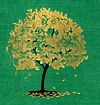 |
"THE SONG OF 'RAINTREE COUNTY'"
The Great (Almost) American Novel Becomes The Great American Film Score
Performing Arts Motion Pictures,
Iris Newsom, Editor.
The Library of Congress,
Washington, DC, 1998
Ross Care's RAINTREE COUNTY Library of Congress article OnLine:
Author's
Introduction: Many hours of my child-and-young adulthood
were spent in the movie theaters of Harrisburg, Pennsylvania.
This combined with a burgeoning interest in composition and music
in general and film music in particular led to my early literary
efforts to write seriously about the motion picture music of
the late (and declining) Hollywood studio era, the last days
of which I was then experiencing. Like many young Americans of
this period I had also been fascinated with the animated films
of Walt Disney that, after a brief decline in the 1940s, went
into a major renaissance during the formative decade of the 1950s.
Indeed with the various technical innovations (and gimmicks)
of the '50s 3-D, Cinerama, CinemaScope, and Camera 65 -
film music in general also peaked at this time, moving into what
I consider to be its last great classic period.
Part of
this Golden Twilight of the Hollywood studio system was MGM's
film version of Ross Lockridge, Jr.'s epic novel, RAINTREE COUNTY.
Composer John Green's musical score for this film was (and is)
my favorite film soundtrack LP of the period. But the fact that
I was practically the only writer of the period to deal seriously
with the unique music for the classic animation of the Disney
studio helped me first break in print with articles on the scores
and (still generally little-known) composers for the Disney oeuvre
from 1928 through the '50s and early '60s.
I wrote
an extensive piece on Disney composers, "Symphonists for
the Sillys," for Mike Barrier's legendary animation magazine,
Funny World. This came to the attention of Jon Newsom,
then head of the Music Division of the Library of Congress in
Washington, DC, and also a force in the early documentation of
classic film music during this time. Also a pioneering serious
admirer of Disney and animation music in general, Jon invited
me down to the Library at that time I was living in Lancaster,
PA. and indicated that if there was anything of interest
(!!!!) among the Music Division's vast holdings that I'd care
to write about the Library would be interested in publishing
it. I was of course fascinated with the Library's major collection
of original Hollywood scores that had been sent there for copyright
purposes during the last several decades.
Jon's wife,
Iris Newsom, of the Library's Publishing Division, was launching
a new series of deluxe hardback books at this time, what were
originally called the Performing Arts Annuals, each to
deal with the holdings of the Library's various divisions, Music,
Motion Pictures, and so on. My first article in Performing
Arts Annual 1986, was autobiographical, "Memoirs of
a Movie Childhood," and deals with growing up with movies
in the theaters of Harrisburg, and the American movie going experience
of the period in general. It was illustrated with film stills
and graphics from the Library's Motion Picture division, these
augmented with historic theater photos from the Pennsylvania
State Archives (including a photo of Loew's Regent Theater in
downtown Harrisburg where, during my high school years, I first
saw RAINTREE COUNTY in 1957). After this I contributed a variety
of articles to the PA series, including major articles on Cole
Porter and Alex North, these peaking in 1998 with two articles
for Performing Arts Motion Pictures in 1998.
For this
volume I contributed two articles: "Twilight's Last Gleaming,"
an overview of Hollywood music from 1950 to 1965, and the essay
on RAINTREE COUNTY that follows. The RAINTREE article deals with
both the original novel and its film version from my personal
relationship with both during the late '50s, but it also focuses
on John Green's great score, which is by now considered one of
the strongest elements of the film and one of the great Hollywood
scores of all time.
It should
also be noted that this essay only deals in depth with the first
third of this very major score. But in late 2006, and now living
in California, I was approached by Film Score Monthly
in Los Angeles to write the liner notes for their forthcoming
two-CD restoration of the complete Green/MGM score. This was
released to much popular acclaim in early 2007, at the time three
RAINTREE threads on FSM's website message boards collectively
garnering thousands of hits. For this CD release, which followed
the original (and incomplete) RCA Victor albums which were in
turn re-issued in several formats, I was able to discuss the
entire score, plus half a disc of rare bonus material. I should
also emphasize that I wrote the FSM notes "from scratch,"
i.e., they are not a re-write of the following essay and
anyone with an interest in the complete RAINTREE COUNTY score
is strongly urged to seek out the Film Score Monthly/Turner Classic
Movie Music CD restoration. (FSM
two-disc set, Vol. 9, No. 19).
After graduating
from college I was still listening to RAINTREE COUNTY and was
inspired to write a letter to composer John Green. The following
essay also includes excerpts from Green's response, here included
in the article for the first time, along with the personally
autographed photograph he enclosed. These were sent from London
where he was working as musical director for the film version
of OLIVER! That his score and composing for films in general
was, at this time (1968) still essentially unrecognized, indeed
ignored, is indicated by Green's comment: "Your references
to the aesthetic reward or lack of same in connection with the
writing of film music triggers so large a topic as to rule out
discussion in a letter of this kind."
I can only
hope that somehow John Green and the other once-obscure composers
of this era are now somehow aware of the recognition and love
their then-unsung work has so avidly - even obsessively - inspired
and achieved over the past few decades.
And I'm
so grateful I was able to express my admiration and respect for
Green's own work to him when I did.
Ross Care, Ventura, California, June, 2007

Raintree County: The Period, The Novel
In the 1950s, when Hollywood optioned
seemingly everyone on the American literary scene for a movie
"adaptation", from Herman Melville, William Faulkner,
and Jack Kerouac to Erskine Caldwell, John O'Hara, and Grace
Metalious, it was often the era's unsung film composers who in
fact most vividly captured the American essence of these writers'
works in the often questionable film versions derived from them.
Indeed certain composers, such as Alex North and Elmer Bernstein,
became singularly noted for their ability to lend emotional life
to such grandiose attempts at bringing the printed page "to
life" onscreen.
North, of
course, began an auspicious career with his haunting music for
Tennessee Williams' Broadway play, "A Streetcar Named Desire,"
going on to evoke such varied but quintessentially American authors
as Faulkner: (The Long Hot Summer, The Sound and the Fury), Edward
Albee (Who's Afraid of Virginia Woolf?), and James Leo Herlihy
(All Fall Down). Bernstein's career moved into high gear with
his celebrated ` score for the film of Nelson Algren's contemporary
novel about drug addiction, The Man With The Golden Arm, and
continued to sympathetically enhance such diverse adaptations
as Algren's Walk On The Wild Side, Erskine Caldwell's God's Little
Acre, James Michener's Hawaii, and the best Tennessee Williams
film after Streetcar, Summer and Smoke. Very appropriately, Martin
Scorsese chose Bernstein to score his recent film of Edith Wharton's
The Age of Innocence.
Whatever
its other positive and/or dubious side-effects, going to the
movies in the 1950s provided a crash course introduction to both
American and world literature (including Shakespeare for whose
Julius Caesar MGM supplied Marlon Brando, Deborah Kerr, and a
Miklos Rozsa score!) Inexpensive paperback "movie tie-ins"
in Signet, Perma Book, and Bantam editions completed one's education:
along with many other works, you could purchase a play by Tennessee
Williams, complete with original cast and credits and a four-page
spread of movie stills, for thirty-five cents at your friendly
local drugstore or news shop. (When John O'Hara's mammoth "From
The Terrace" appeared at a whopping ninety-five cents a
copy it was considered an economic, as well as a literary scandal.)
In February
1957 a fifty-cent Dell paperback with a distinctive watercolor
cover of Montgomery Clift and Elizabeth Taylor in an intense
and obviously troubled embrace hit the stands: "Raintree
County" by Ross Lockridge, Jr. Above the title was the simple
claim "A great American novel", a remarkably restrained
avowal given the usually excessive and often lurid hype with
which most paperbacks (and films) of the day were promoted. While
a relatively modest addendum printed at the bottom of the cover
informed the reader that "Raintree County" was "now
a great Metro-Goldwyn Mayer production", aficionados of
film and literature (often one and the same in those culturally
rich times) already well knew it was an MGM movie, thanks to
breathless movie magazine accounts of Montgomery Clift's well-publicized
re-casting opposite Elizabeth Taylor (they had played together
in the depressing but popular A Place in the Sun in 1951) and
with whom, wags insisted, he shared an intense (if then puzzlingly
platonic) relationship. "Raintree's" pre-release notoriety
was further enflamed by the handsome Clift's disfiguring car
crash in the middle of the expensive production. Just how "great"
the film was, however, remained to be seen.
In small
print under the title's distinctive type font (only slightly
varied from the original hardback edition) was a single word:
"abridged". Whoa! The paperback edition clocked in
at 512 pages; for the prospective reader the inevitable question
was, how long might the unexpurgated version be? After at last
seeing the film (a very mixed but still strangely compelling
bag) further investigation led me to my local library and the
book's original full-length 1948 version, clocking in at 1060
pages and now disappointingly sheathed in the neutral (and very
uncinematic) binding of most library editions of the day, at
least for those books which managed to survive beyond their initial
best (or non-) selling print-runs. It was nearly a decade since
"Raintree" had been published, when I first found the
complete edition still available in the Harrisburg, Pennsylvania
public library. (The generic library binding might also have
been a result of the novel's distinctive original dust-jacket
painting: an anonymous hand seen grasping what appears to be
either a canvas or map of an Arcadian landscape, the contours
of which form the graphic outlines of a female nude, a recurring
image in Lockridge's poetic and often highly erotic prose. An
alternative "Book-of-the-Month Club" edition featured
a somewhat less controversial dust-jacket illustration: Adam
and Eve clad in prim 19th-century garb, and receiving a golden
apple from an obliging serpent).
I first
experienced Raintree County, the movie, the book, and
its amazing musical score, at a formative period in my life,
my first years of high school which also spanned both the last
days of one of my favorite theaters, Loew's Regent in downtown
Harrisburg, its ultimate demise a precursor to the 1950s trust-busting
binge which spelled "The End" for MGM's chain of theaters,
and the last gasp of the Hollywood studio system in general,
of which "Raintree" was a key manifestation. I was
also flexing my wings as a composer and, thanks mostly to MGM
and Disney, and to having loved movies since the dawn of consciousness,
soon became instinctively and avidly aware of the era's vivid
film music.
Raintree
was one of the first films to really catalyze this life-long
fascination with music and image. As a budding orchestrator,
I was particularly struck by "Raintree's" basically
conventional yet inventive orchestration: for example, its simple
but distinctive use of a tambourine in the "Footrace"
and "July Picnic" sequences, and even more notably,
the wordless female chorus and mysterious shimmer of bell-like
sounds woven into the orchestra, which (belying the mundanely
literal visualization in the film itself) actually turned "Johnny's
Search For The Raintree" (as the soundtrack album identified
the cue) into the mystical experience adumbrated on the back
of the paperback edition: "The legend of the Raintree is
the age-old tale of man's quest for the unattainable. In every
time and every language poets have sung of it - the Tree of Life
in the Garden of Eden... Apollo's tree bearing golden apples
in the Garden of the Hesperides....mysteriously transplanted
to the heart of frontier America." Pretty heady stuff for
a 16-year old, but Johnny Green's ecstatic, pantheistic score,
a sensual and highly empathetic evocation of Ross Lockridge,
Jr.'s unique, multi-faceted novel, made it all palpably real
and possible, and in a manner much more haunting and visceral
than the film itself.
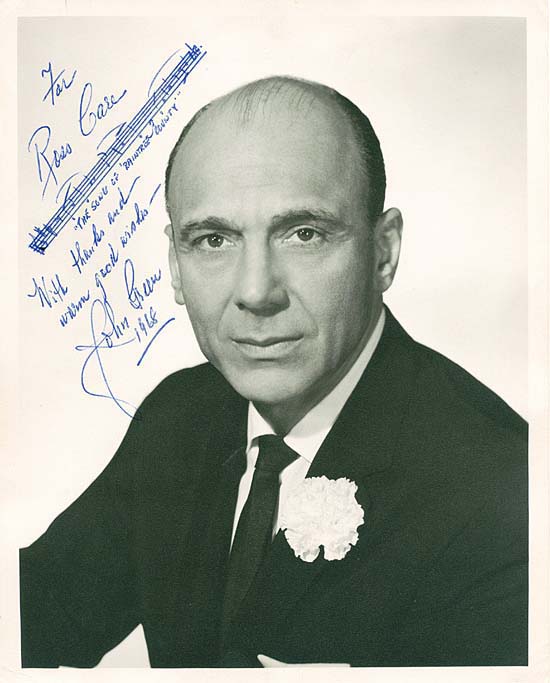
In an era
when stars like Clift and Taylor were the profusely publicized
gods and goddesses of creation by a relatively restrained (by
today's
standards) media, I had no idea who either composer Johnny Green,
or author Ross Lockridge, Jr., were (though I was struck by the
fact that I had finally found a namesake somewhere in the arts.)
What I did know was that something about "Raintree"
struck a chord deep within me, in no small measure because of
its evocative musical score, making the film itself an unforgettable
experience which I longed to recapture. So, on my first visit
to the legendary Sam Goody record store in New York, I found
myself agonizing over whether I should buy the two-record RCA
Victor album of the "Raintree" score, an unprecedented
and expensive (for a high-school student) item at the time, or
settle for the single-disc "highlights" album so as
to also afford the first relatively complete soundtrack of "Snow
White" which had also just been released as part of the
new Disneyland Records series of WDL-4000 original soundtracks.
Such were the naive consumer quandaries of the popular culture
addict of the late 1950s!
I never
regretted settling for the "Raintree" highlights album,
and "Snow White," but when I finally acquired the double
"Raintree" album some years later (at a much more expensive
price as a highly sought-after out-of-print collector's item),
I was thrilled anew by a score which in the meantime had become
one of my (and many people's) most durable favorites, a thrill
experienced again on listening to recent CD re-issues. (In 1972
the July issue of "High Fidelity" was devoted to film
music and listed the then-current going-price for the two-record
"Raintree" set at $150.00, while also imortalizing
the tantelizing anecdote about the legendary "Raintree"
cut-out double albums which had allegedly very briefly surfaced
at Goody's bargain outlet in NYC!)
I've never
really stopped listening to Green's score, and when I guested
on my local PBS station's "Desert Island Discs" radio
program a few years ago, I had no qualms about including a track
from "Raintree" - the beautiful and self-contained
"July Picnic" cue which had so stuck me on my original
viewing of the film - as a sample of one of the eight discs with
which I would select to be shipwrecked. And of course Green's
score, and the film which occasioned it, led me to the original
novel which the music so vividly evoked, and to the curious,
quintessentially American and conflicted life of the novel's
author, Ross Lockridge, Jr.
"Raintree
County," the novel, has maintained its reputation and place
in American letters strongly enough to have inspired two biographies
of its author, "Ross and Tom" by John Leggett, and
Larry Lockridge's "Shade of the Raintree: The Life and Death
of Ross Lockridge, Jr." (though both the dust-jacket and
title page of the latter book make sure to identify Lockridge
as the "Author of 'Raintree County'", in deference
to contemporary readers presumed unawareness). Larry Lockridge's
fascinating book addresses everything that anyone who has ever
gotten though his father's intimidating yet fascinating tome
might wish to know, providing many of the details of family history
and background which Ross wove into the book, as well as the
saga of its publication and exploitation.
But the
blurb on the back of the original dust-jacket sums up the "Raintree"
saga in a nutshell: "In April of 1946, Ross Lockridge, Jr.,
carried 'Raintree County' to the office of the Houghton Mifflin
company in a suitcase. The manuscript, weighing twenty pounds,
was piled on a table in an antechamber, where the author and
editor sat peering at each other over and around this Matterhorn
of literature. In a few weeks the manuscript was accepted and
a contract signed. Still to come were the Metro-Goldwyn-Mayer
Novel Award and other successes for the Indiana writer's first
novel. The contract, however, was the first tangible reward of
a determination made by Lockridge at the age of seven to become
a writer." The PR for the original edition, superficially
a classic American literary success story, could not foresee
the unhappy conclusion of the "Raintree" saga, nor
could anyone reading this terse literary success story have envisioned
the tragic real-life denouement of the author: in March of 1948,
before any production work on the film had begun, Lockridge shut
himself in his family garage in Bloomington and committed suicide.
The somewhat
rocky cinematic history of "Raintree County" was fairly
assured by its having won the lucrative MGM Novel Award. Larry
Lockridge describes the competition as follows: "First held
in 1944 in a highly publicized campaign to corral valuable literary
properties, the contest would be increasing the award in 1947
to $150,00 for the author, $25,000 for the publisher, with several
escalator clauses that would bring the total to $275,000 for
the author. The sum $150,000, the equivalent of $1,050,000 in
1993 currency - with escalators, close to $2 million - was the
world's largest literary prize.
"My
father was unimpressed. The rules guaranteed no role to the author
in scripting or production, and he was an author who wished to
control his novel's fate to its extremities. He noticed that
previously winning novels were 'flashy, vulgarly constructed
novels with an obvious eye on the movies,' and no distinguished
films had yet resulted. He wished to script any film adaptation
himself." 1 The eventual MGM ad campaigns
for the film touted the film as being based on "the prize-winning
panoramic novel" while neglecting to mention they had bestowed
the prize themselves! (The grandiose double-page movie magazine
ads also hyped the film, shot in the new big-screen process,
"MGM Camera 65," as being "In the great tradition
of Civil War Romance," a tacit reference to "Gone With
The Wind," which "Raintree" recalled only in its
period setting. The author's name appeared in the last line of
the copy, in type considerably smaller than the "Print by
Techicolor" credit).
Like its
predecessor and most covert influence, James Joyce's "Ulysses,"
"Raintree County" is the story of one day, "A
Great Day for Raintree County, July 4, 1892," and like "Ulysses"
that day is described through a complex filigree of flashbacks
and stream-of-consciousness monologues and narratives. No less
than three chronologies - one for the events of the day itself,
one listing the chronological order of the incidents described
in the flashbacks, and one for the actual historical events that
bear on the plot - are included to "assist the reader in
understanding the structure of the novel." 2
Perhaps only Alain Resnais or some such auteur of the European
New Wave (or now a television mini-series), could possibly do
justice to the original Lockridge novel, a book "written
by a modern for moderns," as the dust jacket also announced.
In 1950s Hollywood, with its emphasis on linear narrative and
near hysterical romantic emotionalism, "Raintree County"
was (next to the then utterly unfilmable "Ulysses")
a screenwriter's worst nightmare come true.
Composing The Music of RAINTREE COUNTY
Composer Johnny Green (who, after a short period at the studio
in the early 1940s, took over the position of general music director
for MGM in 1949, and who originally studied economics at Harvard
before gravitating to a career in music) was, besides being a
consummate conductor, music director, and composer/song-writer,
an articulate scholar and gentleman of the "old school"
whose expertise far exceeded the realm of music. His observations
on the problems involved in transcribing the original novel to
the screen are astute: "The novel from which the screenplay
was taken was by no means a straight line story. Though effective
and moving, it was diffuse and involved. Its emotional complexities,
its criss-crossing tensions and surges, its heterogeneous flashbacks
demanded of the reader the greatest possible concentration. One
found oneself time and again turning back to refresh memory and
re-establish contact. These problems had to be faced by Millard
Kaufman in constructing his screen play and by Edward Dmytryk
in interpreting the development of the story and the characters
on the screen." Green discreetly but frankly concluded:
"Despite their great skill, vestiges of the diffuseness
and involvement of the original came through on the screen to
some extent and presented serious problems to the composer."
3
Green
goes on to describe some of these musical/dramatic problems and
his potential solutions:
"My first decision had to do with general approach. The time: mid nineteenth-century. The place: a fictional and prosperous county in Indiana just preceding, during, and immediately following the Civil War. The atmosphere: the fantasy of the Legend of the Raintree (symbolizing Man's endless quest for the unattainable) superimposed, in not too clear-cut a fashion, on a most realistic and practical set of situations.
"What should be the style, what should be the context of the music? Would there be the inevitable juxtaposition of 'The Battle Hymn of the Republic' against 'Dixie'? Should the score be based on indigenous music of the period? Should the music have a 'modern sound' and, if so, to what extent? Should block color or melody be the predominant characteristic? I even considered the possibility of a totally source music score, meaning that all the music would come from a source within the action, either seen on the screen or implied.
"Almost immediately I ruled out source music in favor of a completely theatrical approach. Next, I vowed that there would be no 'Battle Hymn/Dixie' goings-on and that the thematic material would be original (to the degree that this is possible with me). I then determined that the score should be romantic in feeling, that it would be melodic and that it should have what we know as 'that modern western sound,' not 'Wagon Wheels' of course, but rather the pentatonic and, to some degree, polytriadic sound that, under the able aegis of certain composers too well-known to require mention, has become the trade mark of the open spaces in recent serious American music." 4
Probably the most striking aspect of the score as I've come
to know and study it over the years, is its timeless simplicity
and elusive style, the result of a dynamic fusion of most of
the techniques described above. Green's music does not have the
immediately recognizable style of North or Elmer Bernstein in
their peak period, yet neither does it sound like anyone's else.
And, despite of what Green himself notes about the influence
of serious American composers, he nonetheless manages to evoke
a vivid, haunting sense of Americana without resorting to the
Copland-isms he himself suggests in the above quote.
As a composer
Green also has the strong, concentrated melodic and harmonic
sense of a great songwriter, as witness his harmonically audacious
"Body and Soul" with its unprecedented modulations,
and the more straightforward but equally haunting "Easy
Come, Easy Go," which Green later integrated into the score
of "They Shoot Horses, Don't They?" (1969), unfortunately
his only other major score to equal "Raintree's" significance
(though his contribution therein is primarily as musical supervisor/arranger
for period standards which supplied a bitterly ironic counterpoint
to this frankly depressing account of 1930s dance marathons).
The "Raintree"
score takes its essential character from "The Song of Raintree
County," and is thus basically lyrical, or "melodic"
as Green also notes above (while also integrating aspects of
the "block color" approach he also cited). The song
is also a rare instance of a title tune satisfying both the artistic
and commercial demands of the medium and industry. Green spoke
frankly (and with the voice of one who, as head of the expensive
MGM music department, took such considerations in his stride)
about the decision to include an exploitable title song in the
context of a serious historical drama: ".... a practical
and perplexing problem... Should there be a song? The current
vogue in so-called title songs has become a bugaboo to all of
us who work in films. That it has been overworked to a fare-thee-well
there is no doubt. That a smash title song ranks high among the
top exploitation and promotion media that a movie can have is
also an established fact. That 'Raintree County' represented
a cost of over five and a half million dollars was already common
knowledge when I approached my job. Could I, in good composer's
conscious, accede to the pressure for a title song? I decided
that I could. Hence, 'The Song of Raintree County' with lyrics
by Paul Francis Webster." 5
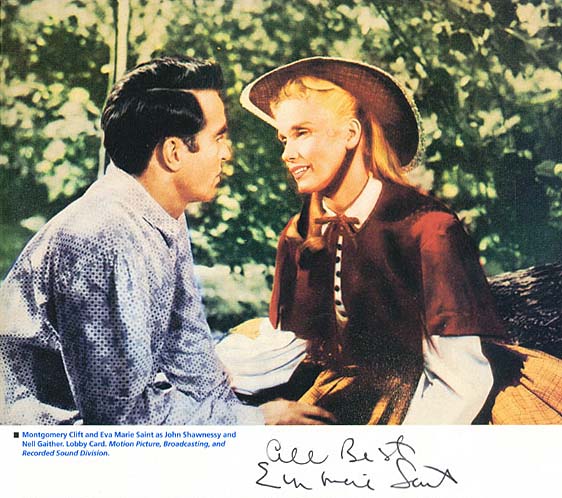 |
Green
also decided to apply to the score as a whole a technique somewhat
eschewed in modern film scoring, the use of leit motifs. The
epic nature of the story itself, combined with its melodramatic,
near-operatic characterizations and incidents - a mad heroine
straight out of a Southern Gothic "Lucia"! - made such
a choice both practical and appropriate. "What to do about
the diffuseness, the multiple lines, the crisscrossing emotional
conflicts? Decision: straightforward leit motif. A theme for
every important character (or combination of characters), locales,
emotional element. Result: thirteen thematic entities with specific
story identifiability (there are additional transitional and
independent motifs, of course). Thus I hoped to provide certain
clarifying 'islands' or 'audio-reminders' that would help the
audience, if only subconsciously, to orient individual events
and character relationships to the whole." 6
One might also bear in mind that "Raintree"
was a product of the pre-video age when audiences were expected
and indeed required to digest a film in one viewing (or at most
only a few) during its relatively brief release (though, like
a few classic, i.e., especially expensive MGM offerings, "Raintree"
was briefly re-issued).
Both film
and score fall into three major sections, following the linear
plotline, which focuses primarily on the hero, John Shawnessy
(Montgomery Clift) and his two conflicting loves, that screen-writer
Kaufman extricated from Lockridge's complex and cross-dissolving
paean to 19th-century America. In the process (and probably of
necessity!) about two-thirds of the characters and incidents
in the book were discarded. The film's opening sequences describe
the hero's late youth and coming of age in a mystical pastoral
Indiana, and his naive relationship with his college sweetheart,
Nell Gaither (Eva Marie Saint). In the middle section the plot
thickens as he is tricked into marriage with a beautiful but
disturbed Southern belle, Susanna Drake, (Elizabeth Taylor) and
this section also tracks their atmospheric, indeed Gothic, interlude
in New Orleans and the pre-Civil War South of the girl's troubled
childhood. The third and final section brings on the war, and
the birth of John and Susanna's son, leading to Susanna's demented
flight south during the war, her temporary restoration but eventual
death prior to the happy and decidedly non-Lockridge Hollywood
ending as Johnny walks off into the sunset with his own true
love, Nell, under an imposing (if botanically incorrect) Raintree!
Important secondary characters maintained from the book include
Johnny's mentor and companion, the arch and Byronic "Perfessor"
Jerusalem Styles (Nigel Patrick); the brash but good-hearted
rural rake, Flash Perkins (Lee Marvin ), initially Johnny's opponent
in the July 4th foot race but later his Civil War buddy; and
Johnny's rival, the smarmy politician Garwood B. Jones (Rod Taylor).
Impossibly
managing to both tie together and ultimately galvanize a problematic
screenplay, Green's lyricism (embodied in his evocative sense
of orchestral color and skillful, dramatically astute contrapuntal
development) magically evokes the essence of Lockridge's complex,
overtly sensual and pantheistic novel to a far more sublime extent
than anything else in the pedestrian (if maddeningly charismatic)
film version. The visual iconography of Clift, Taylor, and Saint,
and the near-Hardyesque ambiance of the location shooting (Nell
sweeping through a lushly Arcadian landscape as Green's motif
for she and Johnny sweepingly sounds the Olympian promise that
their college graduation and Lockridge's book both celebrate
and lament; the eerie visit to Susanna's burned-out plantation,
with its brilliant musical equation of psychosis and racial hysteria)
sublimely capture the despairing glory to which Lockridge's valiant
book is a testament. And of course Green's score is absolutely
it, the most magical mystical element in a movie that unfortunately
eventually runs out of both steam and conviction over the course
of two-hour-plus running time. But despite these few (and not
inconsequential) positive elements, MGM/Hollywood star quality
at its best, and Green's superb score, the film is frankly a
travesty of the author's Joycean stream-of-consciousness narrative,
as how could it not be in an era when screenwriting rigidly adhered
to a strictly linear mode of plotting.
The Beginning of The End: The Studio System in the Late 1950s
Raintree County was among the last "big"
pictures produced in Hollywood with the considerable and heretofore
durable resources of the studio system, resources which were
already beginning to crumble during the 1950s. An 1954 article
on the MGM music department (where money once flowed like water)
commented: "Whether Johnny Green's financial training influenced
Metro-Goldwyn-Mayer to name him administrative head of their
music department, with its $2,000,000 annual budget, I do not
know, but the fact remains that a dollars-and-cents outlook carefully
governs his actions as head of this complex activity. With a
contract composing staff which includes Miklos Rozsa, Bronislau
Kaper, Andre Previn, Adolph Deutsch, George Stoll, Jeff Alexander,
Charles Wolcott, and Green himself, MGM seldom goes outside its
own walls for free-lance compositional talent. The current policy
of restriction to staff composers is influenced by the considerations
of economy, a major factor in all Hollywood operations today
in view of the uncertainties created by TV competition and the
unsettled problems of 3-D and stereophonic sound, etc."
7
As
general music director it was Green's responsibility not only
to assign the various composers their films, but also to oversee
the placement of music therein. In the mid-1950s MGM still maintained
more than one hundred persons in the music department as a whole,
including (besides composers) arrangers, conductors, copyists,
librarians, orchestra players, music coaches, and administrative
personnel. Green also cited the "decidedly controlled editorial
supervision" of the studio's music, noting that a kind of
musical "script" was prepared for all of the studio's
dramatic pictures. Running as long as ten to twelve single-spaced
typewritten pages, these scripts completely outlined the use
of music in each picture: its general character, whether it dominates
or is "under" the action, etc. (The music "script"
might be compared to a "story treatment" which sets
out similar parameters for a film's dramatic requirements). During
the period of Green's administrative duties at MGM, it was he
and his associates, including the producer and director, who
fashioned these musical outlines, usually watching the unscored
picture countless times, re-running sequences that were under
particular musical consideration. Ideas and comments were taken
down verbatim and roughed into the music script which was then
presented to the composer who, along with Green and his staff,
prepared a cue-sheet with exact timings for the musical episodes.
Once finalized, this cue-sheet, with its split-second timings,
was the final guide for composer and conductor. 8
Green's
final score for "Raintree County" is notated in five
bound volumes, the first of which represents a version of
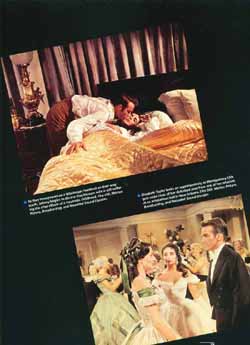
the musical script described above. Besides detailed timing
charts for each musical cue, often with references to the actual
spoken dialogue in each sequence, volume I also includes Green's
personal notes and comments to the various arrangers (most taken
from his actual pencil score) who assisted on the film, and detailed
cue-by-cue lists of the instrumental and vocal ensembles required
for recording, as well as instructions as to when and how these
orchestral/vocal tracks were to be linked and superimposed on
one another, special effects (such as "reverb"), and
lyrics for both the Main Title and "Never Till Now,"
the song developed from the euphoric Johnny/Susanna love theme.
Concerning
his use of a staff of arrangers Green wrote: "An orchestrator
by profession, I compose my motion picture dramatic music in
detailed, seven line orchestral sketches. Why not, then, go the
rest of the way and work in full score? Because, even before
the panic sets in, there just isn't enough time under the scheduling
system that prevails. The small time spread between even the
most detailed sketches and the full score provides the differential
between 'making the date' and not making it. There is no orchestration
credit on 'Raintree County' because the overwhelmingly major
portion of the score was committed to paper in my own fully detailed,
seven line sketches. When, however, towards the end of the composition
period, my remaining time was suddenly cut in less than half,
a group of talented, good friends rallied round to make the impossible
recording date possible. After meticulous projection room discussion
and sessions at the piano with me, Alexander Courage, Sidney
Cutner, Robert Franklyn, Conrad Salinger, and Albert Sendrey
each adapted and arranged my detailed sketches for certain remaining
scenes." 9 Volume I of Green's final
bound set also includes some credits as to which arrangers worked
on which sequences, these becoming more detailed towards the
end of both picture and score. The supplementary arrangers were
generally assigned specific sections of the film: Sid Cutner
handling the Civil War sequences in at the beginning of Part
II of the film, Conrad Salinger contributing the end cues, and
so on; Albert Sendrey, and some others seem to have worked on
a variety of cues throughout.
The Score(s)
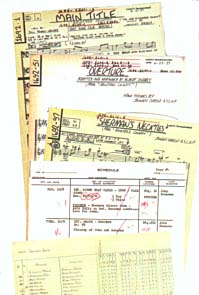
definitive edition
Green's final five-volume score for
"Raintree County" is dated September 13, 1957, and
is dedicated to his daughter, Bonnie. Volume I is divided into
five sections, with sections II through V listing the actual
cues as they finally appear in score form in volumes II through
V. The score volumes are also arranged by reels: volume II/reels
1-6, etc. Cues are listed as they are heard in the film, and
also numbered G1, G2, etc., G referring to the sequence of the
pieces in Green's bound volumes. Exact timing data and instrumentation
for each cue are also included, and some (but not all) are dated.
These bound volumes are no doubt the "detailed, seven line
orchestral sketches" of which Green spoke in his liner notes,
and are indeed thoroughly notated, down to such minute technical
details as Green's notations for pedal changes in the harp part.
While Green's
original volumes are now at Harvard, the Library of Congress
in Washington also has photocopies of the original studio piano
conductor's score of the "Music Score of Phonograph album
'Raintree County'. Received on Dec. 11, 1957, this is the copy
sent to the Library by MGM for copyrighting purposes. The phonograph
album score, dated 6-25-57 by Loew's Incorporated, is in the
beautifully executed style of all the MGM scores of the period,
a key example of the meticulous work of the studio era's music
copying departments, while Green's volumes are done mostly in
free-hand pencil, clear and also quite meticulous, but not always
easy for the non-professional eye to decipher. An album of piano
themes, "The Music of RAINTREE COUNTY" (Robbins Music
Corp., New York, NY, 1957, $1.25), was also published at the
time of the film's release, and a copy (dated Nov. 19, 1957)
may also be found in the Music Division.
In the following
score discussion reference will be made to both the Green and
Phonograph Album scores, as well as to the written data and notes
contained in Green's volume I. Space considerations limit my
in-depth investigation of the score to cues from the opening
Indiana sequences (admittedly, for me, the most lyrical and atmospheric
sections of both film and score).
Section
one of Green's Volume I lists the film's major credits, and notes
that its world premiere was in Louisville, Kentucky on October
2, 1957. The composition period of the score is cited as November
1956-May 1957. The notes in section one pertain mainly to the
film's road-show engagement "Overture," but also include
Paul Francis Webster's first draft of his lyrics for "The
Song of Raintree County," dated April 10, 1957:
The way to Raintree County
Can't be found on a map or a chart.
Like me you'll find that Raintree's a state of the mind
or a dream
in your heart.Long ago one day
with the buds of early May
up you came like a flame from the South!
And I looked into (laughing eyes so bright and blue)
Eyes of periwinkle blue
and I knew;
then I knew - -I'd love you in Raintree County
and I'd learn what we all seek to know
We shared a golden dream when we found our true love
In Raintree long ago.For the brave who dare
there's a Raintree everywhere,
We who dreamed found it so long ago.
Webster's words are basically the same as those used in the
final version of the song; the main concepts are all there and
in need only of a few instances of fine-tuning. Green commented
that his challenge "...was to write a melody, with a certain
folk flavor, which would serve well as the thematic representation
of Raintree County itself, of a locale and its people, have popular
appeal as a song and yet dovetail with the color and style of
the total score," while Webster's was "...to use the
words 'Raintree County' with the title, to create a lyric that
would be comprehensible in today's incomprehensible song market,
to maintain some definite relationship between the words of the
song and at least the feeling , if not the story of the picture,
to be commercial and yet be literate enough to 'belong' in the
company of the rest of the elements of the film." 10
Webster,
who created effective lyrics for a variety of title songs from
the period, managed to tastefully meet the considerable demands
cited by Green. The main revision in the original lyrics quoted
above occurs in the first two lines, the lyricist opting to insert
a terse reference to the legend of the Raintree which suffuses
both book and film: "They say in Raintree County There's
a tree bright with blossoms of gold," then just slightly
varying the next two lines: "but you will find the Raintree's
a state of the mind, or a dream to enfold." The song as
a whole is compact, and the expected second A section (of the
usually strict AABA form of most pop songs of the period) never
happens; instead, Green and Webster move directly to the B (or
bridge) section with its reference to the Elizabeth Taylor character,
the "flame from the south." The final A section manages
to merge both the obligatory reference to "love," requisite
in any song of the period ("I'd love you in Raintree County....")
and finally the informing concept that Green refers to as "the
essence of the picture" and which serves as a kind of coda,
"..... For the brave who dare there's a Raintree everywhere,
we who dreamed found it so, long ago," a phrase which even
manages to suggest the original (and unpunctuated) closing lines
of Lockridge's book: "....of some young hero and endlessly
courageous dreamer"
Nat King
Cole (a rather curious choice for a film the heroine of which
is driven mad by, among other things, her paranoia over having
"nigra blood") performs the song as the film's Main
Title. Due to contractual restrictions Cole's version is not
included on the RCA soundtracks, but he did record "The
Song of Raintree County" as a Capitol single and on an LP
album of movie songs;11
while the single did not prove a major hit, the song itself
was included on many of the then-popular movie theme "mood"
albums of the day. Both scores include Cole's vocal line and
orchestral accompaniment, though only Green's includes the two
additional brief cues, "The Lion" (for the MGM logo),
and a transition into the song referred to as "Nat King
Cole Capitol Intro" which leads directly into the "Main
Title Nat "King" Cole version". A cue for the
12-voice male choral back-up to the Cole solo is included in
the Green score, but no copy of the mixed choral version arrangement
used on the record album is to be found in either score. A complete
version of the title song, and "Never Til Now," the
song developed from the Johnny/Susanna love theme (but not sung
in the film), are both included in the piano album as well.
The melody
of "The Song of Raintree County," a folk-like diatonic
theme in which the repeated perfect 5th intervals of the opening
phrases build to a poignant suspension effect on the word "find",
permeates the first third of the score, weaving into and out
of the cues and various other motifs in a manner richly suggestive
of the original novel's stream of consciousness style. No matter
how much new material is introduced in the score's opening cues,
each element seems to marvelously gravitate to a duly transformed
reprise of the title theme, thereby reinforcing the hyper-lyrical
"Raintree" motive (and its charged symbolic mythos)
in the minds and hearts of the audience.
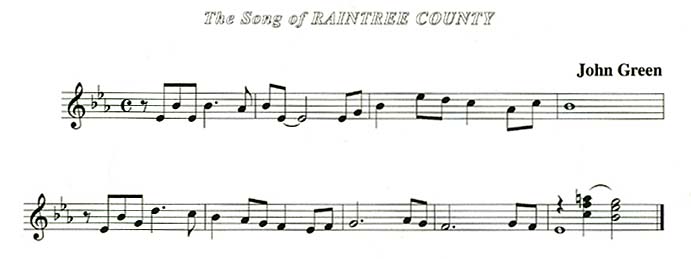
Reel 1, Part 1: "Overture" - "Nell and Johnny's
Graduation Gifts"
Both scores open with the road show "Overture",
"adapted and arranged in part by Albert Sendrey from themes
by Johnny Green, ASCAP." The most complete version is found
in the record album score, while Green's copy omits the Susanna/Johnny
love theme which forms the middle section of the album "Overture.
Green's personal notes also list several unused thematic sequences
considered for the "Overture," including the "Swamp
Agitato," "The Carriage Ride," a "War Commentary"
theme, and an "Emotional Tension" subject. At one point
Green also notes: "Call Sendry May 4th with 'Never' development".
The first
actual cue in the film (after the Main Title song slowly fades
out over a series of establishing landscape scenes) is "Nell
and Johnny's Graduation Gifts," built mostly on transformations
of the optimistic motif that springs from a simple major chord
in the second inversion, but given a modernistic cast with its
prominent use of major 4th intervals.
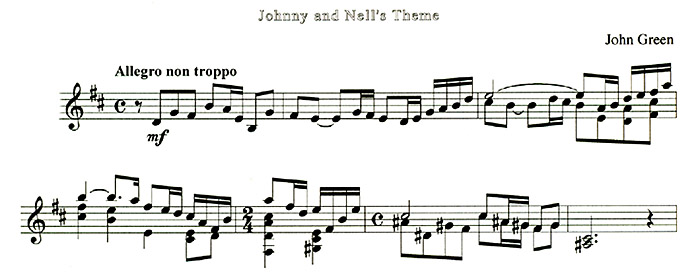
The instrumentation is marked: 2 fl.; 1 ob-E.H. (English horn);
2 cls. (A & B-flat); 1 bass cl. (3rd cl if wanted); 1 bn;
3 hrns' 1 harmonica' 1 perc- triangle; bells; 1 hp' 1 cel; 14;
4; 4; 2 (these latter numbers referring to the string section):
total instruments: 38. This cue appears on the album almost exactly
as it is heard in the film, underscoring the sequence in which
Johnny and his Raintree County sweetheart, Nell, exchange graduation
gifts in a sunny woods. Like most of Green's cues in his personal
volumes, this one is notated in the seven stave format he described
above; his notes to his orchestrator (here unspecified), are
included. For a shot of Nell crossing the stream, Green suggests:
"This is now a rich flowing pastoral - string-lead tutti
- warm with shimmering wws (woodwinds), fluid harp, etc, the
soft bells, celeste, etc." When Nell presents Johnny with
his gift of a book on Raintree County Green notes: "This
is a straightforward statement of the Raintree song. The melodic
burden to be entirely with the strings - Completely simple
- dialogue style." (A harmonica solo nonetheless
captures and elaborates the already poignant melody.) As Johnny
and Nell exchange an emotionally charged glance, Green explicates:
"This is a big string lead tutti - the big open country
- much warmth - pastoral style, wws. perhaps - but don't cover
the tune!". That so subtle an exchange as that of mere glances
should elicit from Green so pointed and precise a musical response,
points to that incredible symbiosis between music and emotion
that Hollywood in this period (and Green uniquely in this instance)
inherited from the legacy of European romanticism. No date is
attached to this "Johnny/Nell" cue.
Reel 2, Part 2": "There's Another Tree"
The next cue is a brief but evocative track, "There's Another Tree," (not heard on the soundtrack album). It underscores the Professor's description of the mystical Golden Raintree which, local legend holds, Johnny Appleseed brought to the heart of frontier Indiana (interestingly, the idea presented here is essentially that expressed on the back of the paperback edition: a lovely Americana myth that gilds the novel's tortured psychologies with a homegrown transcendent grandeur). Scored for 2 flutes (1 doubling alto flute), 1 oboe, 2 clarinets, 1 bsn., horns (Green's asks "2 or 3, Al?' suggesting Albert Sendrey or Alexander Courage worked on these sections), 3 percussion: bells, xylophone, vibraphone, and "small cymbal-metal rod" and a note with "finger cymbals" crossed out and replaced by" "Raintree Jimjik," 1 harp, 1 celeste, strings: 14, 4, 4, 2. (No total here). "Echo Chamber" is also written and double-underlined on the title page. The cue is an exotic, mystical variation on the title song, scored for highly reverbed (and atmospheric) alto flute solo and tremolo strings divided in three and four parts, which vividly underscores the Professor's narrative (including a "chinoiserie" spin on the bridge) about the oriental origins of Appleseed's planting. Needless to say, the cue sublimely tracks the profound feelings that the Raintree and its attendant symbolism arouse in the questing Johnny. Date: 5/3/57.
Reel 2, Part 2: "Johnny's Search For The Raintree"
The Professor's provocative narrative leads directly to "Johnny's
Search For the Raintree," one of the most ecstatic and pantheistic
sections of the score, and one of the film's most celebrated
cues. The orchestra is expanded here, mostly by a full 4/3/3/1
brass section, along with additional percussion including 4 timpani.
Green notes that the "Raintree Jimjik will be separately
recorded," as will be 6 high soprano voices. Strings are
also expanded (22/6/6/4), bringing the orchestra to a total of
64.
Titled simply
"The Swamp" in Green's score, the cue is a contrapuntal
fusion of all the motifs heard in the score so far, including
hints of the "Nell and Johnny" theme (suggesting that
their love may already be the answer to Johnny's youthful search)
and introduces new material in the form of the mystical motif
of the great Swamp itself, a combination of an ascending bass
arpeggio preluding the mystical half-step swamp motive (C-D)
heard almost immediately in the unison female voices.
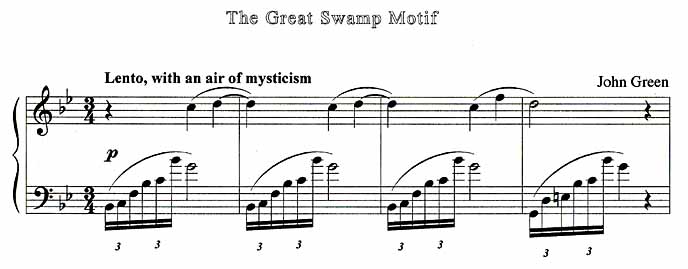
A fragment of the Raintree song, its opening perfect 5ths, is
heard in solo horn (marked "hauntingly" at measure
6) as the swamp motif extends itself in triplet figures in 4/4
and 3/4 while the accompaniment remains in 12/8 and 9/8. As the
wordless voices soar to a high obligato (measure 11) the full
melody of the song is heard in the cello section in a high register
as the vocal obligato continues, escalating from unison to thirds,
and finally to ecstatic full triads at the "mystic"
parallel chords which always form the transition to the song's
bridge.
At measure
22 the voices revert to unison for a statement of the bridge,
but a series of abrupt and rather jagged cuts on the soundtrack
of the film suggest that there was some last minute tampering
with the visual structure of this sequence. In the film the 4-part
horn chord at measure 21 is repeated, an obvious and rather awkward
studio edit, and a large and quite abrupt cut (which includes
the end of the bridge and the reverbed trombone reprise of the
song's main melody with its lovely solo violin and harmonica
counter lines) is made to measure 28, the "Subito molto
agitato" section where Johnny falls into a hidden pool.
Cuts continue in the film music track, including some measures
dropped out of the agitato fugato treatment of the song melody
underscoring Johnny's struggle in the water, and some bars are
also snipped from the beautiful transitional coda, with its reprise
of the swamp motif heard in solo oboe as the mystical voices
"ahhhh" the "Song of Raintree County" to
bring the sequence to an unexpectedly tranquil close.
Fortunately,
the cue as Green composed it is heard in its entirety on the
soundtrack album. That there were some problems with this sequence
during the post-production period is also suggested by the fact
that Green's score has an insert (noted as measures 27a to 27g)
with a crossed-out measure at the end. Though no arranger credit
or date is included with Green's sketch, a somewhat smudged comment
at the "agitato" section at measure 28 states: "Al,
please add no preparation, wws. (?), hp. gliss. or the like.
The complete shock is the intent here". At the same point
(where Johnny falls into the pool in the film) Green notes the
sopranos' climactic high B-flat as "Quasi scream"!
While up
to this point the film is promisingly engaging, due primarily
to idyllic location shooting in the Nell and Johnny scenes, and
especially to the cynically witty dialogue and arch characterization
of Nigel Patrick as the Professor, the swamp sequence, with its
picturesque but sadly mundane imagery - at one point Green notes
the "big bird shot" in his score - is something of
a let-down. Nothing in the literal visualization of this sequence
measures up to the poetry with which Ross Lockridge, Jr. evoked
the mystical pantheism of his mythic Raintree County, or indeed
to the very Lockridgian music which Green created for this key
sequence. (Which is no doubt why the sequence was ultimately
trimmed).
In the cinematic
"Raintree" director Dmytryk seems more successful with
actors, particularly the males, than with mood or atmosphere.
The swamp sequence, more than any other in the film, also suggests
that MGM got to "Raintree County" several years too
late: episodes such as this should have called forth the magical
poetic naturalism of such location/studio fusions as "The
Yearling" (not to mention the on-location naturalism that
director Clarence Brown and MGM brought to their unexpectedly
authoritative realization of Faulkner's "Intruder In The
Dust"), and of certain studio hot-house films like "The
Pirate" or sections of other musicals such as "Ziegfeld
Follies". The Swamp sequence would surely have benefited
from some of the studio poetry of the sequence from "The
Yearling" when Jody finds the fawn in an artfully artificial
Florida glade and carries it home against the backdrop of a luminous
MGM cyclorama of Maxfield Parish cloudscapes. But by the late
'50s even MGM had lost its ability to convincingly stylize the
lush, highly atmospheric studio look that found its apotheosis
in the 1940s (as films like "Raintree" and "Green
Mansions" sadly proved). Traces of this ambiance fleetingly
appear in "Raintree County," for example, in the New
Orleans episodes, some of which have the soft-focus mezzotinted
look of Minnelli's "Limehouse Blues" sequence in "Ziegfeld
Follies". The swamp cue is also undated.
Reel 3, Parts 1 & 2: "Freehaven"/"Flash Perkins"
After a brief cue, "Nell and Gar", underscoring Johnny's post-swamp encounter with Nell and Garwood Jones (and cut from the final print), the scene shifts to the rural Indiana town of Freehaven, and a jaunty, folk-like motif for Flash Perkins, with its infectious banjo sound, and syncopated, pseudo ragtime rhythm.
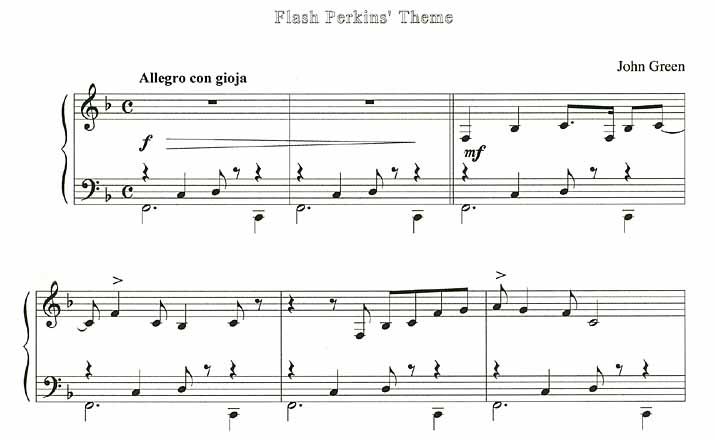
Green's score includes two "Freehaven" cues, and it's
the second (G11), titled "Freehaven 2nd Revised," dated
7/30/57, and marked "Andantino alla Campagna," that
is heard in the film. The major cue in this section is "Meet
Flash and Susanna," dated 5/6/57, and which is introduced
by a brief "Prelude" (Reel 3, Part 2A, 5/13/57); both
underscore Johnny's meeting with Flash Perkins (Lee Marvin),
a bragging rake who challenges Johnny to a spontaneous footrace.
Green notes concerning the two opening cues: "This is a
direct seque-as-one at bar 2 from end of reel 3, part 2A - 'Prelude
to Meet Flash and Susanna'. Will be recorded as one piece."
Sections of this cue are heard as the "Flash Perkins"
record album track, but since the exciting musical build-up to
the race is abruptly cut off in the film when the Professor calls
a halt and reschedules it for the 4th of July, a climactic alternative
ending was written for the soundtrack album, and is included
in Green's score. The episode also introduces Susanna, whom Johnny
briefly glimpses as a crowd gathers for the race, the first brief
statement of their main love theme being intercut into the "Flash"
music (but not included on the albums). On the title page of
"Meet Flash and Susanna" Green notes: "Clarinetists
in this piece must be 2 of our jazz men" and "Please
get Jack Marshall on banjo (tenor). He will need capo."
A brief undated cue, "Johnny's Crown" (Reel 3, Part
4, and marked "Allegro rimato - sardonically"), concludes
the outdoor Freehaven sequences.
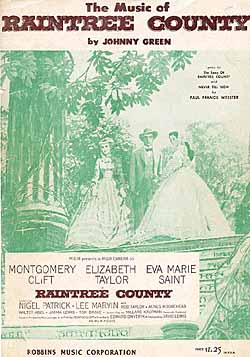
Reel 4, Parts 1 & 2: "Johnny and Susanna's First Meeting"
Reel 4 opens with Johnny's visit to the photographer's studio
where he first meets Susanna Drake. The score here is divided
into five cues, including two inserts in addition to the main
cues, with the pivotal cue being "First Meeting", Reel
4, Part 1. (These various cues are edited into the track "Johnny
and Susanna's First Meeting" on the album.) Only the opening
and closing cues in Green's volume are dated: 5/13/57 and 5/14/57,
respectively. The orchestration is for a reduced orchestra of
about 38 with an emphasis on strings and reeds. The scherzo-like
cue "Look at the Birdie" opens reel 4, cut off midway
by an "Insert" which interjects a fully-developed statement
of the "positive" love theme at measure 8 as Johnny
sees Susanna being photographed as she poses in a draped white
Greek gown, clutching a lily, and looking drop-dead gorgeous.
Liz gives the first in a series of marvelously unspontaneous
shrieks as she notices Johnny and rushes off to change. The lyrical
love theme is interrupted by a light scherzo variation as Susanna
is seen hurriedly changing so she can catch up with Johnny, and
the cue fades as he reluctantly leaves the studio.
Just as
Johnny is exiting Susanna rushes out to meet him (Liz shrieking
"Wait for me!" in another "unladylike" outcry
which is referred to in the ensuing dialogue), and the main cue,
"First Meeting", commences. This is primarily a development
of the love theme, pure and simple. At one point Green notes:
"Al: this next section is a simple, tender, warm and straightforward
statement of the Susanna-Johnny Happy Love Theme. The melodic
and harmonic burden is to be entirely in the warm strings unless
otherwise specifically indicated. Please add no element, harmonic,
rhythmic or linear that does not appear here. Do not spread any
counter element so as to place it above the top of the melody
line. We are behind dialogue all the way!!! Please indicate
in this sketch exactly who's playing what as you score!!!"
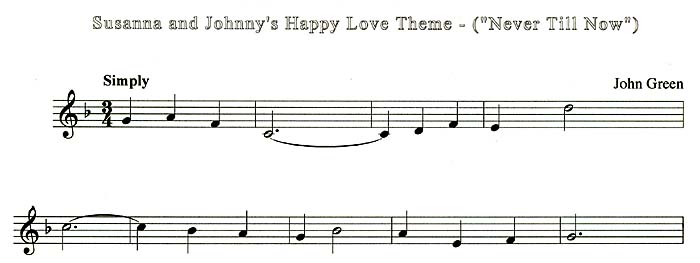
As with the "Johnny's Search" cue, there seems to have
been some re-editing of the film sequence. There is an alternate
bar at measure 25, succeeded by several deleted measures and
an added cue, "First Meeting (Insert)" The insert brings
the cue to a momentary conclusion in tandem with the Professor's
line, "Boy, you are definitely ready to graduate!",
when he sees Susanna on Johnny's arm. There also appears to be
an unspecified cut of an entire page at measure 29, and around
measure 35 Green notes "DO NOT COPY - THIS IS A DELETION
- AN ERROR -NOT A CUT!!!," after which the cue more or less
proceeds as notated, moving on to the statement of the "Happy
Love Theme" Green described above.
The cue
also includes a lovely but vaguely troubled variation on the
love theme, harmonized in open 5ths and 6ths, which lends an
appropriate premonition of melancholy to the cue as a whole.
There are actually two variants of "happy" love theme
used throughout the score. The first is a languid, semi-pastoral
version in 6/8 time with slight harmonic variations. The second
variant is the one described above, in 4/4 with the opening motif
harmonized in 5ths and 6ths and slightly extended and developed.
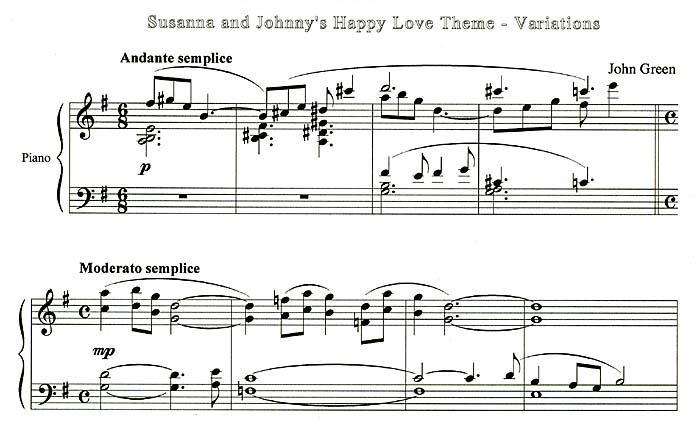
Reel 4 ends with a brief coda, Nell's Huff," in which,
seeing Johnny with Susanna, she displaces her anger and slaps
Garwood; his stunned reaction is Mickey-Moused with comic muted
trumpets, in Green's words: "Harmon" (a type of brass
mute) "but not jazzy".
The ensuing
sequence involving the 4th of July footrace, and the Professor's
unsuccessful plot to get Flash Perkins drunk and keep Johnny
sober by surreptitiously substituting tea in Johnny's bourbon
bottle, opens with a close-up of the winner's wreath of oak leaves
(referred to in the "Johnny's Crown" cue) held by Susanna.
The footrace episode is one of the book's more celebrated passages,
and was reprinted in "Life" magazine at the time of
the novel's publication. The entire sequence is unscored except
for a few instances of source band music in the background (and
another great outcry from Liz as a firecracker is exploded near
her hoopskirt in the opening shot). Even the footrace itself,
so vividly evoked in the "Flash Perkins" album cue,
goes unscored.
Reel 5, Parts 4-6; Reel 6, Parts 1-4: "July Picnic"/"Train From The South"
The "July Picnic" sequence (along with its emotionally
charged "coda") is perhaps the peak of Green's by turns
heroic, by turns wrenching, lyricism. It heartbreakingly distills
both the idealistic aspirations of the American "experiment"
(which Lockridge's entire book throws into hopeful/despairing
relief), and that mid-summer sense of emotional ripeness and
decay which Johnny and Susanna's romantic peak-and-subsequent-downfall
so inexorably illustrates. Perhaps only Franz Waxman's underscoring
for the same holiday in "Peyton Place" is Green's equal
in both celebrating and mourning the day's unique mood of promise
and defeat.
After John
wins the footrace, the scene shifts to the streamside Independence
Day picnic of John, Susanna, the Professor, and Lydia Grey (the
beautiful but married object of the Professor's affections).
Green makes up for the absence of music in the preceding footrace
sequence by providing uninterrupted scoring for the entire picnic
scene, and its ensuing sequence, Johnny's later encounter with
Nell after Susanna has left Freehaven. Two short additional cues
support the concluding episodes which document the aftermath
of the Professor's botched attempt to escape Raintree County
with Lydia Grey. The picnic sequence is divided into several
cues - "Pursuit of Happiness," (no date), "July
Swim," (5/14/57), "Tell Me About the Raintree"
(no date) - all underscoring the sequence which climaxes with
Susanna's seduction of Johnny, while the "Dell Insert,"
(7/1/57) and "Your Exact Location" (no date) cue John's
brief but emotional reunion with Nell after Susanna has returned
to the South. All of these cues are heard intact in the 6.01
"July Picnic" track on the album.
"Pursuit"
is a brief introductory cue for the picnic scene, and a scherzo-like,
syncopated variation on the happy love theme which develops to
a swirling climax as Johnny and Susanna frolic in the stream
and collapse in a secluded spot on the bank. When Susanna asks
about the Raintree, (in one of Taylor's most subdued and touching
moments), Green supplies an equally moving variation on the title
song with contrapuntal lines for harmonica and the wordless female
choir heard in the swamp sequence: "Tell Me About The Raintree".
As Johnny and Susanna passionately embrace, the music peaks over
a discreet fadeout, continuing uninterruptedly as the scene shifts
to Johnny and Nell in the fields, with an ecstatic development
of the Johnny/Nell motif in solo trumpet and strings. Green again
noted his desired effect: "Again the big open pastoral quality
as in Reel 1, Part 2 - the upper woodwinds moving around the
inner harmony. The two harps and celeste helping the float and
shimmer continually." He further adds humorously: "immer
der schimmer, toujours la schmour" and "sempre I spaghetti,"
adding on page 143, "relax the flax." John's conversation
with Nell, "Dell Insert," as he speculates on becoming
a great writer, effects a moody antiphonal development of their
motif, fused with the "Raintree" song theme, and the
cue concludes with another full-length variation on the title
song as Johnny and Nell temporarily reconcile: "Your Exact
Location". With these several cues contained in one continuous
flow of music, one is struck by Green's impressive skill at both
developing his motifs in a cohesive, dramatically compelling
fashion, and deftly integrating appropriate and highly atmospheric
variations on the resilient title tune into the underscore.
Several
brief cues (all undated)--"Going Home" (Reel 6, Part
3), which is also found in the revised version heard in the film
(Reel 6, Part 3A), and "Train From the South" (Reel
6, Part 4, here arranged by Alexander Courage)--provide hints
of the polytonal brass chords, some built on 4ths, which will
characterize several of the later Deep South/Civil War cues.
The brief brass "Train" cue, also marks the end of
the film's first section, and the symbolic end of Johnny's youth.
As the train on which the Professor finally escapes pulls away,
he bestows on Johnny his richly cynical last word, with this
departing comment: "Dear friends, remember me as someone
who loves Raintree County, but just happens to loathe everyone
in it," at which point Johnny finds Susanna on the platform,
newly returned from the South with the news that she is pregnant.
The Rest of the Score
While this opening third features some of Green's most charismatic
and lyrical music, his score continues to grow in power as the
screenplay moves into its long-in-coming (and somewhat laborious)
resolution, maintaining a consistency and depth that unfortunately
eludes the rest of the film. Space prohibits further cue-by-cue
discussion of this wonderful American musical classic, but mention
should be made of Green's highly original music for the gradual
manifestation of Susanna's dementia, as well as his haunting
(and haunted) cues for the sequence in which John and Susanna
visit the burned-out shell of her childhood mansion where she
formed a deep and lasting attachment to her Negro nurse, Henrietta.
Green uses
a motif based on the expressionistic interval of F-sharp
to F-natural, sometime B-natural to B-flat, and first
heard on an anachronistic but oddly appropriate alto sax (with
added reverb effect) to represent Susanna's madness. There is
also a more agitated secondary "mad" motif of 16th
note triplets which whirl over a counter melody based on
a whole-tone scale. (See "Triplet Mad Motif").
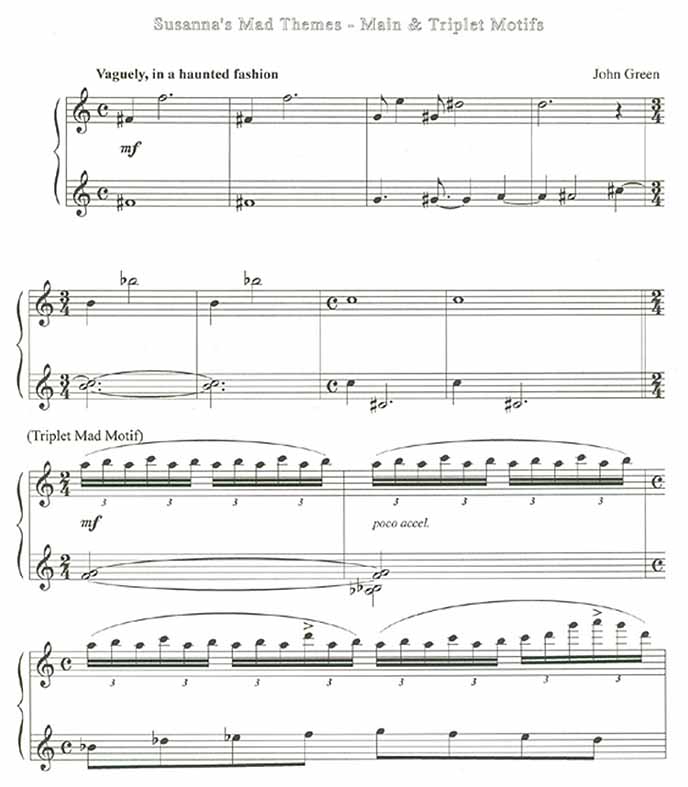
The ethereally melancholy "Lament for Henrietta," heard as Susanna describes her tormented childhood, begins with a hint of the same interval, suggesting the connection between Susanna's condition and her conflicted attachment to the black woman who took the place of her also mentally disturbed biological mother, and with whom her father was having an affair. This lovely melody is first heard in solo flute, also with dreamy reverb, and later in full strings.
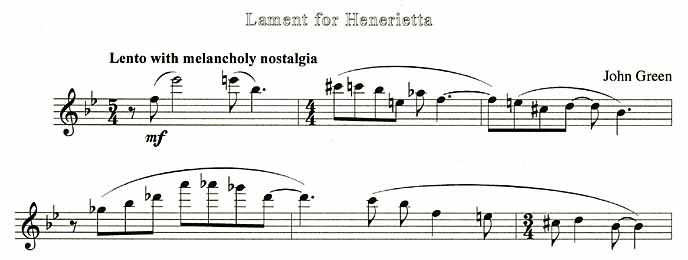
As the film moves from its opening sequences in the mythic Indiana
of the hero's youth, to his coming of age in the Civil War and
a disturbing marriage which ends in Susanna's (rather contrived)
death, Green's score accordingly develops in depth and complexity.
The orchestration, ably realized by Green's staff of six assistants,
is relatively traditional, with an emphasis on strings and a
well-utilized reed section, and an escalating use of brass in
the latter sequences. But along with this basic instrumentation,
the modernist tone of Lockridge's novel is also evoked by the
use of modern recording technology.
Most obvious
is the aural motif for the Golden Raintree, an electronically-concocted
shimmer of bells, notated by a cymbal-style "X" with
an ensuing downward glissando sign in the score. This sound,
which Green arbitrarily named the "Jimjik" - "the
equivalent of 'thing-a-ma-bob,' merely an identifying handle"
- was separately recorded and given its own channel in the final
mix (when it was added to the previously-recorded orchestral
tracks), and is just one example of the forward-looking recording
techniques that make "Raintree" an early masterpiece
of multi-track studio scoring and overdubbing. Green described
the mechanics of the effect and its technological application
within the score: "A good toy glockenspiel, scraped from
top to bottom by two pairs of brushes (one pair following the
other - two percussionists, of course) produced the effect. On
the recording stage, to the naked ear, it was virtually inaudible.
It achieves the characteristic heard on the sound track via multi
magnification and maximum reverberation (echo chamber). The exact
method of producing it was later worked out by trial and error
on the recording stage." 12 The "Jimjik"
effect is usually heard to the mystical parallel triads heard
between the first (A) section of the "Song of Raintree County"
and its bridge (B).

The score's technological aspects are particularly notable in
the Southern sequences when Susanna's dementia begins to escalate,
notably in the eerily nostalgic "Burned-Out Mansion"
cue, made-up of several individually recorded takes - male voices
and banjo, a plantation polka for strings, and a basic orchestral
track - all of which was superimposed on tape (to click tracks
carefully indicated in the score with mathematical precision).
Electronic enhancement also evokes the frankly mystical elements
in the film's first third: the reverberated voices in "Johnny's
Search For The Raintree," and the similarly enhanced harmonica,
female voices, and sensuous alto flute in the "July Picnic"
cues. Green's technical notations - "alto sax, pure tone
in echo chamber" - are an integral part of his detailed
orchestral sketches.
Green touched
upon of the mysteries of studio composing and recording which
are such an integral part of the total "Raintree" sound
in a reference to the motif for Susanna's favorite doll, Jeemie,
a motif closely related to her dementia music: "The doll
motif, recorded as a separate entity, was composed and orchestrally
arranged in such as manner as to be played against the basic
Mad Theme during the re-recording or dubbing process. In other
words, that which emerges on the sound track as a single piece
of contrapuntal music, was never played as such on the recording
stage. The arithmetical niceties of timing, meter, and the like
are sufficiently intricate to form the basis of a separate article."
13
Some
of the complexities of the process can be seen in a description
of the collaboration between composer and sound engineer involved
in creating one of the brief (2.21) doll cues made up of two
separately recorded tracks overdubbed to play back simultaneously,
(as Green described above). For "Where Is That Doll"
(reel 12, parts 3 and 3X, , or numbers G51 and G52 in Green's
personal score), Green explored both the technical and psychological
aspects of his music and motifs in a note to recording engineer
Bill Steinkamp: "This piece (G52) works along with the basic
music track (G51) starting and ending as above indicated. This
is the doll motif and works in and out (of G51) as a kind of
a 'sick haze' - barely heard, yet there. We first become
aware of it when Susanna says, 'Where is that doll?' As Johnny
says, 'Come to bed' - we loose it. As she says, 'No, I must find
it,' it somehow is there again, having started to sneak in on
the second of the two 'no's' that precede the complete sentence.
As Johnny says, 'Don't you remember, etc.' it's gone again. In
the silence following Johnny's '.... a long time ago'
it is heard a couple more times, and is gone as J. puts
arm around Susanna to lead her away." Green's note concludes
with an emphatic comment on balance: "At no time is this
track as loud as the track it is running against!!!" Detailed
timings are attched to the notes for these cues, as they are
for most of the cues in Green's first volume: 0:20, Susanna:
"Where is that doll?", 0:50, Johnny puts arm around
Su to lead her, etc.
In his "Film/TV
Music" article Green cited Steinkamp and his contributions
to the score: "Any discussion of the music score of 'Raintree
County' would be incomplete without enthusiastic thanks to the
artist who was at the electronic controls during the re-recording
process, William Steinkamp. It is his masterful combining of
all the sound elements of the picture that brings the music to
its completed state on the sound track." All of which reveals
how the composer consummately merged a lyrical and essentially
traditional style with "modernist" elements, both stylistic
and complexly technical, to vividly mirror Lockridge's wildly
ambitious literary fusion of the same dissonant perspectives.
Ultimately, Green's magisterial score, with its free-floating,
perceptive intermeshing of character and emotional leit motifs,
is, in fact, the only element in the film that genuinely reflects
and pays homage to Lockridge's immensely poignant, homegrown
adaptation of Joyce's Olympian stream-of-consciousness meditation
on mundane reality.
Larry Lockridge
also commented on the score in a letter to the writer: "Green
should have won the Academy Award for the 'Raintree County' score,
but the movie itself probably killed his chances. I still remember
the thrill I felt as a kid hearing that score before seeing the
movie. If only the movie had been the score's equal! I met Green
at the premiere in Louisville (when he was still 'Johnny'), and
again many years later here in New York, where some of his music,
including portions of the RC score, were performed at Carnegie
Hall. It is odd, but true, as you say, that despite the movie's
badness a sort of charisma attaches to it. Green thought his
score his own best work." In the same letter Lockridge also
noted the possibility of a new dramatization of "Raintree"
as a TV mini-series. 14
In
response to a letter written to Green long before the recognition
of film music had become fashionable among both fans and academics,
the composer himself wrote to the author of this article:
John Green
10 Vicarage Gardens
London WS England
24 March 1968My dear Mr. Care -
"I am deeply grateful for your extravagant compliments about my RAINTREE COUNTY score, and I am amazed and delighted by the detailed knowledge of the score that your compliments reflect. I was particularly gratified that your favourite spots in the score include several of mine.
Your references to aesthetic reward or lack of same in connection with the writing of film music triggers so large a topic as to rule out discussion in a letter of this kind.
Your reference to the hit songs that I wrote prior to composing the score for RAINTREE leads me to tell you that a large part of my professional life has been spent in the making of music of all kind for films. I started as a rehearsal pianist at Paramount in December of 1929, at the age of just 21.
Yes, I did read Ross Lockridge's novel prior to writing the score.
I wrote about two hours and eighteen minutes of music for the film of which two hours and ten minutes are in the released print. In actual composing and orchestrating time it took me about four months, working around-the-clock seven days a week.
Since 14 April '67 full-time (and from July 7 '66 up to 14 April last part-time), I have been at work, not as a composer, but as the Music Director, adaptor, arranger and orchestrator of the music and lyrics of Lionel Bart for the film OLIVER!. I shall be hard at it on this project and its companion phonograph LP here in London though mid-October of this year.
I left MGM in March of 1958, have been free lance ever since and have done most of my film work during this period for Columbia.
Repeated thanks to you for the joy that you have given me, and my very best wishes to you for success in your own musical work." 15
In reference
to Green's none-compositional film work (the pressures of which
Green himself refers to in the above letter), author Tony Thomas
observed: ".... if Green hadn't been so busy with musicals
he would have been one of the industry's foremost composers."
"Raintree County" verifies this speculation, though
it's sadly ironic that Green's sole major score was put to the
service of such a mundane, though admittedly, if only in retrospect,
charismatic film.
But Green's
vivid musical evocation of the myth of the Golden Raintree remains
a durable lyric masterpiece of the Hollywood studio system's
protracted golden twilight, one still capable of stirringly conjuring
the pantheistic sunlight and Gothic shadows of a unique epic
of literary Americana: The Great American Film Score for what
came very close to being The Great American Novel, if emphatically
not The Great American Movie.
Ross CARE, September, 1995- January, 1996
NOTES:
1. Larry Lockridge, "Shade Of The Raintree," New York,
Viking, 1994. p. 334
2. Ross Lockridge, Jr., "Raintree County," Houghton
Mifflin Company, Boston, 1948. Preface, p. vii
3. Johnny Green, "Raintree County: A Discussion of the Score
by Its Composer," Film And TV Music, (Fall and Winter, 1957-58),
p. 3
4. Ibid., p. 3-4
5. Ibid., p. 4
6. Ibid., p. 5
7. C. Sharpless Hickman, "Movies and Music," Music
Journal, (Jan., 1954): p.31
8. Ibid., p. 31
9. Green, p. 10-11
10. Green, p. 4
11. Several
versions of Cole's vocal may be heard on the 2007 Film Score
Monthly 2-CD restoration of the RAINTREE COUNTY score."
12. Green, p. 7
13 Green, p. 8
14. Larry Lockridge, letter to Ross Care
15. John Green, letter to Ross Care, March 24, 1968
To: Ross
Care Home
